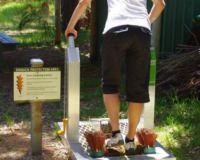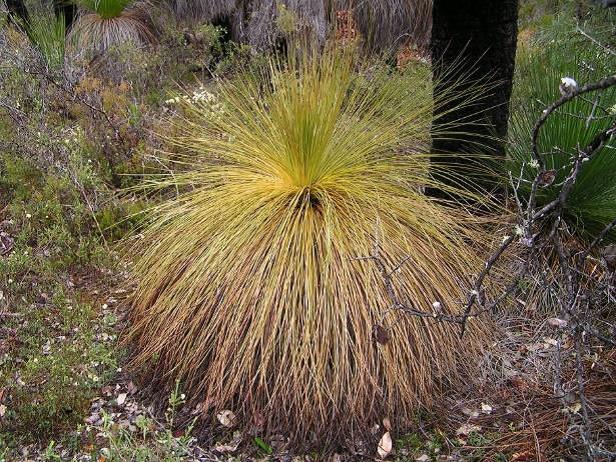Have you ever wondered why native trees and shrubs, in your natural reserve or park, turn brown and die rapidly?
 It may be due to the plant pathogen Phytophthora cinnamomi, which is listed as a key threating process to Australia’s biodiversity for its impact on plants and ecosystems across Australia. In the south-west of Western Australia more than 40% of woody plant species are susceptible to it, including a number of species of the endangered Banksia Woodlands on the Swan Coastal Plain.
It may be due to the plant pathogen Phytophthora cinnamomi, which is listed as a key threating process to Australia’s biodiversity for its impact on plants and ecosystems across Australia. In the south-west of Western Australia more than 40% of woody plant species are susceptible to it, including a number of species of the endangered Banksia Woodlands on the Swan Coastal Plain.
P. cinnamomi was first identified as a causal agent of the disease in Perth’s jarrah forest in the 1960’s. The plant pathogen is an Oomycete (often referred to as water moulds) and unlike invasive plant species they are microscopic, colourless and odourless making it difficult for land managers and environmental volunteers to manage the threat. They survive hot summers, producing swimming spores in wet and warm soil conditions to seek out healthy tree roots. The pathogen infects the roots, eventually cutting off the water and nutrient supply, causing the host to starve. The impact on affected plant communities is profound, affecting flora, fauna and entire landscapes.
Phytophthora Dieback is not restricted to forest or nature reserves, you can have the disease in your garden too. Residents may observe the gradual dying-back of the tree canopy or the sudden death of native plants susceptible to the disease, including iconic tree species such as jarrah and Banksia species. Dead or dying grass trees and zamias are also strong indicators that the pathogen is present. “Research has found that as many as 2284 species in the south-west of WA may be susceptible to P. cinnamomi, and almost a third of these (800) may be highly susceptible,” said Kat Sambrooks, Executive Officer of the Dieback Working Group (DWG). “However, there is action that the public, land managers and environmental volunteers can take and it can be as simple as remembering to Arrive Clean, Leave Clean”.
The disease can be spread by root to root transmission, the movement of animals, drainage and run-off during rain events or the transport of contaminated soil, plant material and water by humans. It is important to remember that any water, wet soil or plant material from infected areas can carry Phytophthora spores for future infection. If you are involved in outdoor recreation (e.g. bush walking, mountain bike riding), gardening, landscaping, revegetation work, construction and road works it’s essential to prevent the introduction of the disease and its spread through implementing rigorous hygiene practices and management actions. The public can assist by purchasing plants from a NIASA-accredited nursery to ensure the trees and shrubs planted in Perth’s gardens are free from disease spreading plant pathogens. The DWG promotes good hygiene and provides clear guidelines and information on the publication page of their website.
If Phytophthora Dieback has been introduced into your natural reserves, parks or gardens you can take action to reduce the impact of disease. Priority plants can be treated with the chemical, Phosphite. The biocidal chemical compound enhances the plant’s natural defences enabling it to survive. Direct treatment of individual trees can be integrated with the replanting of affected areas with resistant species, the relocation of threatened flora and the storage of their seed for future propagation. Improving site drainage to reduce water logging will assist general tree health and help to reduce the spread of the pathogen.
Research is a critical component to the ongoing management of Phytophthora Dieback and the Centre for Phytophthora Science and Management (CPSM) at Murdoch University is internationally recognised for its coordinated research programs. One of the Centre’s most recent research programs is investigating the cause and impacts a canker disease (Quambalaria sp.) has on a keystone species marri (Corymbia calophylla) in the forests of south-west WA. The microscopic fungus enters through wounds or cracks in the trees’ bark and causes infection in the tissue. Marri respond to the wound and produce a layer of callous to contain the infection but the fungus can penetrate through the barrier to produce a distinctive roughly circular canker, like a target. Eventually whole limbs are girdled by this pathogen and die off. Louise Croeser, a PhD Candidate at the CPSM, is investigating the role of a Phytophthora root infection in predisposing marri to this canker disease. “It appears that infected trees do not recover from the canker infection and it is important to understand the factors that predispose marri trees to the pathogen and if there is a possible relationship between it and Phytophthora Dieback”, explained Louise. “Understanding the disease syndrome is crucial because marri provide many ecological services and functions, including food for native wildlife like black cockatoos”.
Information about Managing significant native plant diseases of south-west WA was presented at a recent Perth NRM Professional Development in Environmental Management series seminar by Kat Sambrooks, DWG Executive Officer and Louise Croeser, PhD Candidate, CPSM, Murdoch University. By understanding the environmental impact of these pathogens local government, environmental groups and the community can manage their spread and mitigate the effect of current infestations.

Images showing canker disease (Quambalaria sp.) on marri (Corymbia calophylla)
Photographs: Louise Croeser, Murdoch University.

